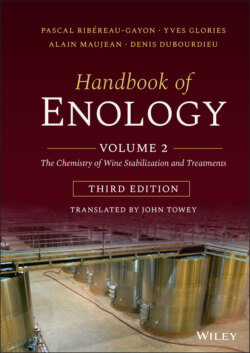Читать книгу Handbook of Enology, Volume 2 - Pascal Ribéreau-Gayon - Страница 64
Hydroxycarboxylic acid ethyl esters
ОглавлениеIn wines, ethyl 3‐hydroxybutanoate is present in its two enantiomeric forms (Lytra et al., 2015). In red wines, its average S/R enantiomeric ratio is approximately 75/25 (±13), with an average total concentration of ~450 (±150) μg/l. Contents of the R form progressively increase during bottle aging, but there are no variations in concentration of the S form. Ethyl (3S)‐3‐hydroxybutanoate is mainly described by solvent and alcohol notes, whereas ethyl (3R)‐3‐hydroxybutanoate has a fruitier and butyric aroma. The individual perception thresholds of the (3S) and (3R) enantiomeric forms of ethyl 3‐hydroxybutanoate as well as that of their mixture (85/15, m/m) are, respectively, 21, 63, and 14 mg/l (Table 2.6), which confirms the absence of any direct impact of this ester on fruity aroma perception in wine, since the concentrations found (on the order of microgram per liter) are considerably lower than the thresholds. Nevertheless, even under these conditions, this compound contributes to the red fruit and fresh fruit aromas of red wines, thanks to specific perceptive interactions (Lytra et al., 2015).
